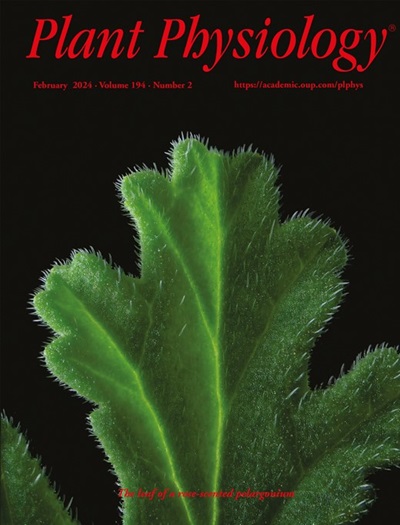通过蓝藻定向进化增强盐胁迫下的光合作用
IF 6.5
1区 生物学
Q1 PLANT SCIENCES
引用次数: 0
摘要
提高光合作用的一个关键方面是改善环境扰动或胁迫后光化学猝灭恢复动力学。盐胁迫加剧了蓝藻的高光胁迫,导致作物严重的产量损失。在不影响光合作用性能的情况下赋予耐盐性的遗传性状对于改善这些条件下的光合作用是必不可少的。本研究通过有条件地抑制长聚球菌(Synechococcus elongatus)的甲基错配修复系统,对PCC 7942进行加速进化,获得有利于盐胁迫下增强光合作用的遗传性状。我们筛选了超过10,000个突变体,并分离出8个在盐胁迫下生物量或蔗糖产量增加的菌株。基因组测序显示,每个基因组平均有8-20个单核苷酸多态性(snp)或索引。值得注意的是,光系统II (PSII)反应中心D1编码基因的突变导致前体D1 (pD1)蛋白羧基端L353F、I358N和H359N的氨基酸改变,通过加速PSII修复过程中D1的成熟,改善了盐和盐光联合胁迫下的光合作用。蓝藻和红藻中pD1的系统发育分析强调了这些适应性遗传性状的广泛相关性,强调了利用进化见解来改善逆境或波动环境下光合作用的重要性。本文章由计算机程序翻译,如有差异,请以英文原文为准。
Enhancing photosynthesis under salt stress via directed evolution in cyanobacteria
A key aspect of enhancing photosynthesis is improving the kinetics of photochemical quenching recovery following environmental perturbation or stress. Salt stress exacerbates high light stress in cyanobacteria and leads to severe yield losses in crop plants. Genetic traits that confer salt tolerance without compromising photosynthetic performance are essential for improving photosynthesis under these conditions. Here, we applied accelerated evolution in Synechococcus elongatus PCC 7942 by conditionally suppressing its methyl-directed mismatch repair system to obtain beneficial genetic traits for enhanced photosynthesis under salt stress. We screened over 10,000 mutants and isolated eight strains with increased biomass or sucrose productivity under salt stress. Genome sequencing revealed an average of 8–20 single nucleotide polymorphisms (SNPs) or indels per genome. Notably, mutations in the photosystem II (PSII) reaction center D1-encoding gene, resulting in the amino acid changes L353F, I358N, and H359N at the carboxyl terminus of the precursor-D1 (pD1) protein, improved photosynthesis under salt and combined salt and light stress by potentially accelerating D1 maturation during PSII repair. Phylogenetic analysis of pD1 across cyanobacteria and red algae highlights the broad relevance of these adaptive genetic traits, underscoring the importance of leveraging evolutionary insights to improve photosynthesis under stress or fluctuating environments.
求助全文
通过发布文献求助,成功后即可免费获取论文全文。
去求助
来源期刊

Plant Physiology
生物-植物科学
CiteScore
12.20
自引率
5.40%
发文量
535
审稿时长
2.3 months
期刊介绍:
Plant Physiology® is a distinguished and highly respected journal with a rich history dating back to its establishment in 1926. It stands as a leading international publication in the field of plant biology, covering a comprehensive range of topics from the molecular and structural aspects of plant life to systems biology and ecophysiology. Recognized as the most highly cited journal in plant sciences, Plant Physiology® is a testament to its commitment to excellence and the dissemination of groundbreaking research.
As the official publication of the American Society of Plant Biologists, Plant Physiology® upholds rigorous peer-review standards, ensuring that the scientific community receives the highest quality research. The journal releases 12 issues annually, providing a steady stream of new findings and insights to its readership.
 求助内容:
求助内容: 应助结果提醒方式:
应助结果提醒方式:


